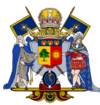Shahnaz Commission: Difference between revisions
(Created page with "The '''Shahnaz Commission''' was a commission of inquiry established in 1717 AN and overseen by the Ministry of Rites and its then minister, Princess Kian. It can be seen as the secular sequel to the Council of Negrixnaht. Steward Louis Thuylemans, himself being a Batavian and catologian, felt that his own faith, just like Tianchaodao, had many similarities with Cedrism. The polytheistic nature and tendency...") |
mNo edit summary |
||
| Line 1: | Line 1: | ||
The '''Shahnaz Commission''' was a commission of inquiry established in 1717 AN and overseen by the [[Ministry of Rites]] and its then minister, Princess [[Kian Aiomide Shahnaz|Kian]]. It can be seen as the secular sequel to the [[Council of Negrixnaht]]. Steward [[Louis Thuylemans]], himself being a [[Batavia]]n and [[Catologism|catologian]], felt that his own faith, just like [[Tianchaodao]], had many similarities with [[Cedrism]]. The polytheistic nature and tendency of both faiths to see a central figure (King or Heavenly Light) as representing the gods, combined with their rather flexible dogmas regarding the interpretation of stories, strengthened his hopes for the creation of a kind of [[State Cedrism]]: a modernized version of Cedrism, which would end the uncontrolled | The '''Shahnaz Commission''' was a commission of inquiry established in 1717 AN and overseen by the [[Ministry of Rites]] and its then minister, Princess [[Kian Aiomide Shahnaz|Kian]]. It can be seen as the secular sequel to the [[Council of Negrixnaht]]. Steward [[Louis Thuylemans]], himself being a [[Batavia]]n and [[Catologism|catologian]], felt that his own faith, just like [[Tianchaodao]], had many similarities with [[Cedrism]]. The polytheistic nature and tendency of both faiths to see a central figure (King or Heavenly Light) as representing the gods, combined with their rather flexible dogmas regarding the interpretation of stories, strengthened his hopes for the creation of a kind of [[State Cedrism]]: a modernized version of Cedrism, which would end the uncontrolled sprawl of countless and sometimes even dangerous small sects that mainly plagued the countryside. | ||
==Thuylemans Memo== | ==Thuylemans Memo== | ||
Latest revision as of 11:24, 12 April 2023
The Shahnaz Commission was a commission of inquiry established in 1717 AN and overseen by the Ministry of Rites and its then minister, Princess Kian. It can be seen as the secular sequel to the Council of Negrixnaht. Steward Louis Thuylemans, himself being a Batavian and catologian, felt that his own faith, just like Tianchaodao, had many similarities with Cedrism. The polytheistic nature and tendency of both faiths to see a central figure (King or Heavenly Light) as representing the gods, combined with their rather flexible dogmas regarding the interpretation of stories, strengthened his hopes for the creation of a kind of State Cedrism: a modernized version of Cedrism, which would end the uncontrolled sprawl of countless and sometimes even dangerous small sects that mainly plagued the countryside.
Thuylemans Memo
The goals of the commission were described in a memo between Thuylemans and Kian. The Steward asked for suggestions regarding:
1. To limit the influence of individual sects on national affairs if they are against the interests of the Imperial Court.
2. Promoting religious unity within the Imperial Republic, with the Kaiser as central figurehead. Faith serves to strengthen the State.
3. Streamlining and collecting the countless religious scriptures, myths and dogmas in one clear - and easy to maintain - catalogue. Under the direction of scribes of the largest sects, the texts should more clearly describe the important role of our Emperors. Think of Raynor I who not only subjugated Rrakanychan, but also managed to bind Malarbor to the Mango Throne.
4. The official recording of prophets to prevent a proliferation of false prophets who can undermine the Empire with false prophecies.
5. Reshaping the Sacred College into a more effective governing body of the faith, without compromising too much on the autonomy of the various cults. The College must become a body where all groups feel represented.
6. Establishing an official religious school to prepare new clergy for their duties. In these institutions, the general dogmas of the faith (and the central role of the Emperor in this) are taught to them, but space is left for lesson packages of the specific religious movement to which the student belongs.
7. Expanding State Cedrism and its institutions to map and incorporate the myriad ecclestial sects into its belief system where possible.
8. In its quest for religious unity, it is of utmost importance to investigate whether (and how) the two new largest faith groups in our Empire (Tianchaodao and Batavian-Catological Church) can be integrated into State Cedrism.
Response
| |||||||||||||||||||||||||||||||||||||
